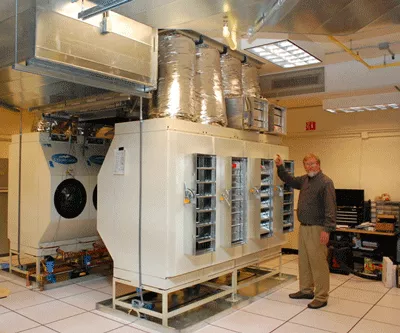The Green Data Center Team at the National Snow and Ice Data Center (NSIDC), part of the Cooperative Institute for Research in Environmental Sciences (CIRES) at the University of Colorado Boulder, has received the Colorado 2011 Governor's Award for High-Impact Research. The team was recognized for its innovative data center redesign that slashed energy consumption for data center cooling by more than 90%, demonstrating how other data centers and the technology industry can save energy and reduce carbon emissions.
The Green Data Center went online in summer 2011. The heart of the design included new cooling technology that uses 90 percent less energy than traditional air conditioning, and an extensive rooftop solar array that results in a total energy savings of 70 percent. The new evaporative cooling units not only save energy, but also offer lower cost of maintenance. The design team was led by NSIDC technical services manager David Gallaher, in collaboration with several Colorado-based companies and the National Renewable Energy Laboratory (NREL).
Researchers around the world who study Earth's snow, ice, and climate, access data from NSIDC's active data archive, a bank of computers and storage devices that require a cool environment to operate. The machines themselves generate heat. "Even in the dead of winter, our computer room air conditioners were cranking full tilt trying to chill off the 100-degree-plus heat coming off the back of these units," Gallaher said.
Just cooling NSIDC's computer room used to require over 300,000 kilowatt-hours of energy per year, enough to power 34 homes. "There was a certain irony that here we are working on climate research and our data center was consuming an awful lot of power," Gallaher said.
The Green Data Center design takes advantage of Boulder's arid climate. "We're using a new technology called indirect evaporative cooling," Gallaher said. These units, manufactured by Coolerado Corporation, cool by blowing air over water, using much less energy than compressors. Unlike traditional evaporative cooling, indirect evaporative cooling does not add humidity to the room, maintaining the dry environment that computers need.
Smart control technology also saves energy. During much of the year, the system cools the data center by pulling in and filtering outdoor air. On hot days, the new cooling units automatically step in. The solar array will normally feed energy back into the electrical grid, further reducing the center's net carbon footprint. In case of a power outage, the solar array will charge the batteries that provide NSIDC's emergency power supply.
"The technology works, and it shows that others can do this too," Gallaher said. "Data centers are big consumers of energy, and a lot of it is for cooling." According to the U.S. Environmental Protection Agency (EPA), as of 2006, U.S. data centers were estimated to consume 61 billion kilowat- hours of electricity, equivalent to the electricity consumed by 5.8 million average U.S. households. By 2020, the carbon footprint of data centers will exceed that of the airline industry.
NSIDC received a grant for the project from the National Science Foundation (NSF) under its Academic Research Infrastructure Program, with additional support from NASA. NSIDC, which is supported entirely by federal research funding, manages scientific data from NSF field programs and from NASA's Earth Observing System remote sensing program.
The Green Data Center was conceived when NSIDC faced an expensive replacement of its aging, ailing computer room air conditioners. The new evaporative cooling units not only save energy, but offer lower cost of maintenance.
The Governor's Award for High-Impact Research recognizes innovations by Colorado's federally sponsored science and technology laboratories that have made significant impacts beyond the labs. Colorado Governor John Hickenlooper will present the award during a reception at the LEEDS Platinum-certified Xcel Energy building in downtown Denver on November 15th.
The Green Data Center team includes David Gallaher, NSIDC Director Mark Serreze, and Ronald Weaver from NSIDC; Rick Osbaugh from RMH Group in Denver; Otto Van Geet from the National Renewable Energy Laboratory (NREL); and Lee Gillan from Coolerado Corporation.
NSIDC supports research into Earth's frozen regions, including sea ice, snow cover, glaciers, ice caps, ice sheets, permafrost, and climate interactions. NSIDC performs scientific research, manages and distributes scientific data, and educates the public.
The 2011 Governor's Award for High Impact Research is sponsored by CO-LABS.
